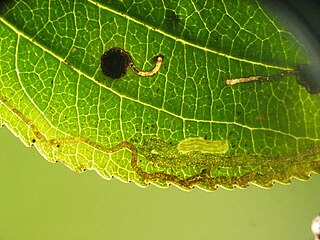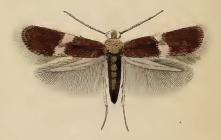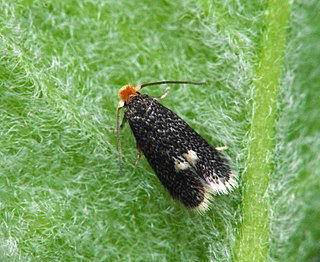
Stigmella confusella is a moth of the family Nepticulidae. It is found from Fennoscandia to the Pyrenees, Alps and Bulgaria and from Ireland to central Russia.

Stigmella lapponica is a moth of the family Nepticulidae found in Asia, Europe and North America. It was first described by the German entomologist, Maximilian Ferdinand Wocke in 1862. The larvae mine the leaves of birch.

Stigmella lemniscella is a moth of the family Nepticulidae. It is found in most of Europe.

Stigmella catharticella is a moth of the family Nepticulidae. It is found in from Fennoscandia to the Pyrenees, Italy and Bulgaria, and from Ireland to Russia.

Stigmella trimaculella is a moth of the family Nepticulidae. It is found in most of Europe, east to the eastern part of Palearctic realm.
Stigmella sorbi is a moth of the family Nepticulidae, described by Henry Tibbats Stainton in 1861. It is found in most of Europe, east to the eastern part of the Palearctic realm.

Stigmella continuella is a moth of the family Nepticulidae. It is found from Fennoscandia to the Pyrenees, Alps and Hungary, and from Ireland to central Russia and Ukraine, east to the eastern part of the Palearctic realm.
Stigmella filipendulae is a moth of the family Nepticulidae. It is found from Fennoscandia to the Alps and the Carpathians, and from Ireland to Poland. There is a disjunct population in Greece.

Stigmella glutinosae is a moth of the family Nepticulidae. It is found in all of Europe.

The banded apple pigmy is a moth of the family Nepticulidae. It is found in almost all of Europe, except Iceland and Norway.

Stigmella myrtillella is a moth of the family Nepticulidae. It is found from Fennoscandia and northern Russia to the Pyrenees, Italy and Bulgaria, and from Ireland to Ukraine.

Stigmella nylandriella is a moth of the family Nepticulidae. It is found in all of Europe, east to Russia, where it has been recorded from Bryansk, Murmansk, Karelia, Leningrad and Voronezh.

Ectoedemia argyropeza is a moth of the family Nepticulidae. It is a widespread species, with a Holarctic distribution.

Ectoedemia subbimaculella is a moth of the family Nepticulidae. It is found in most of Europe, east to Smolensk, Kaluganorth and the Volga and Ural regions of Russia.

Ectoedemia arcuatella is a moth of the family Nepticulidae. It is found in most of Europe, except the Iberian Peninsula, east to and the Volga and Ural regions of Russia.

Ectoedemia occultella, the small birch leafminer, is a moth of the family Nepticulidae. It has a Holarctic distribution. It is found in most of Europe, east through Russia to Japan. It is also present in North America. Mines very similar to that of Ectoedemia occultella have been found on Rosaceae species in Nepal and Japan and these may belong to this species.

Ectoedemia septembrella is a moth of the family Nepticulidae. It is found in most of Europe, east to the eastern part of the Palearctic realm. It is also found in the Near East.

Trifurcula cryptella is a moth of the family Nepticulidae. It is widespread throughout Europe
Trifurcula eurema is a moth of the family Nepticulidae. It is widespread throughout Europe, northwards to southern Norway and Sweden, Poland and the Baltic Region. It is also found in the Mediterranean region, including the larger Mediterranean islands, east to Bulgaria, Asiatic Turkey and Ukraine.

Trifurcula subnitidella is a moth of the family Nepticulidae. It is widespread in Europe southward to the northern border of the Sahara in Tunisia and eastward to the Crimea and Asia minor.















